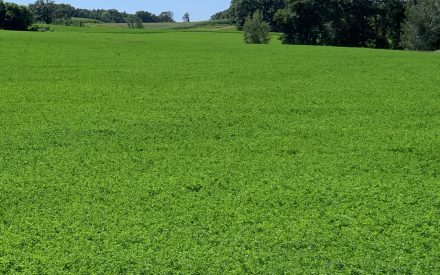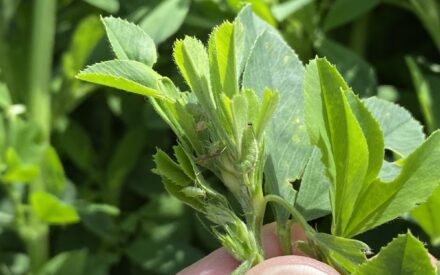Published: Sept. 20, 2024
Cutting alfalfa when the weather is good can be tempting, but late fall cuttings could be damaging to long term alfalfa productivity and stand persistence.
Why it might be bad to cut now
As a perennial crop, one must manage alfalfa with not just this year but the next year in mind. When alfalfa is cut, regrowth begins using stored reserves in the crown and roots, taking significant regrowth (>8-10”) to start filling these stores back up. These same stores have been shown to be quite beneficial to alfalfa winter survival. This is why you often hear that alfalfa shouldn’t be cut within 5-6 weeks of a killing frost.
When to cut in the fall
Research shows that if more than 900 Growing Degree Days (GDD Base 41F) remain before a killing frost, alfalfa can regrow and replenish root reserves to levels high enough for winter survival. We have passed this threshold across Wisconsin. Alternatively, we can cut alfalfa timed so that there is not enough time for regrowth to occur and draw down root reserves. The threshold for this is <360 GDD remaining before a killing frost. Between these two values is a sort of “no cut zone” in which cutting could be detrimental to stand health, depending on winter conditions.
Know your location’s “No Cut Zone”
In many parts of Wisconsin, we are still in that “no cut zone”. But how can you know that? Well, we have a brand-new tool for that, of course! Use the Alfalfa Cutting Tool to look at historical data tailored to your area to help make a cutting decision or to assess your winterkill risk after a fall cut. Simply select your area and use the ‘Growth Projection’ tab and setting a cut date. This will give you a personalized graph like the one shown below for Arcadia, WI.
GDD Projection from Sept. 20 (Arcadia, WI)

Effects of dry weather on regrowth
Recent dry weather may change this relationship slightly, as alfalfa regrowth is dependent on moisture as well as GDD. This could slow down the regrowth enough that the window of 360GDD is more like 400, but there is no clear science here. It is also important to remember that alfalfa has access to water through deep taproots, and deep soil moisture is still at reasonable levels in much of the state (WI Mesonet). Add to that some recent rains for many areas of the state and this extended period may not be something to bank on.
Drawbacks of a late cutting
While leaving alfalfa standing in a field going into winter can feel like a waste, there are some benefits to doing so. Standing alfalfa can help to catch and retain snow. The insulation of snow can significantly increase winter survival of the stand. Though higher in quality, one should also keep in mind that the actual yield in these late fall cuttings can be quite low, making for expensive forage.
So, like all things in farming, your decision will be a tradeoff between your winterkill risk tolerance and your individual forage needs, especially for higher quality forage following a wet spring. But keep in mind that damage to alfalfa persistence limits total productivity in following years, so it is important to manage for persistence in all stands you intend to keep in production.

 Managing fall alfalfa cutting for persistence
Managing fall alfalfa cutting for persistence Alfalfa Fall harvest and the buildup of reserves
Alfalfa Fall harvest and the buildup of reserves Applying manure to alfalfa
Applying manure to alfalfa ▶ Forage Insect Pest Update
▶ Forage Insect Pest Update


